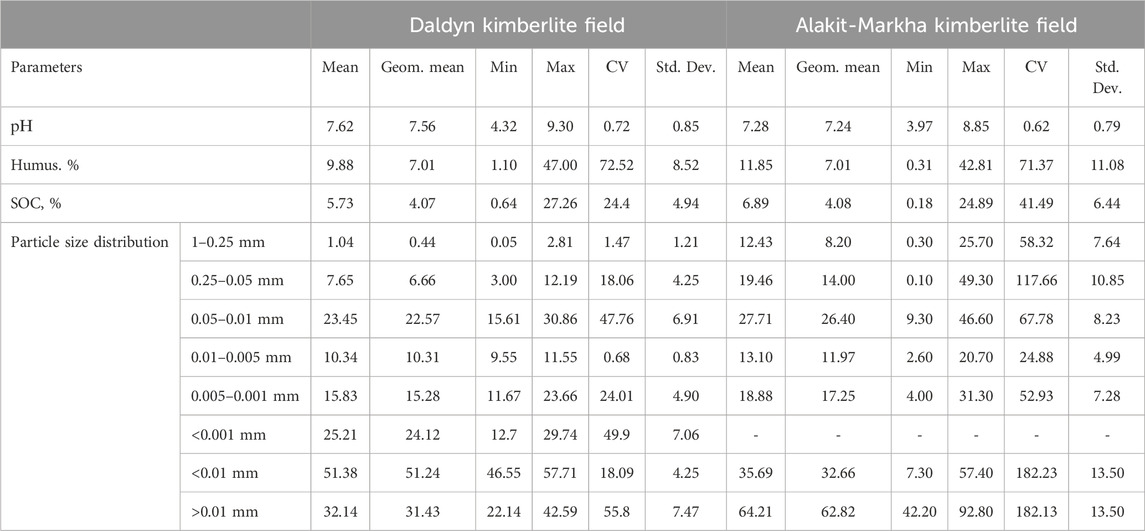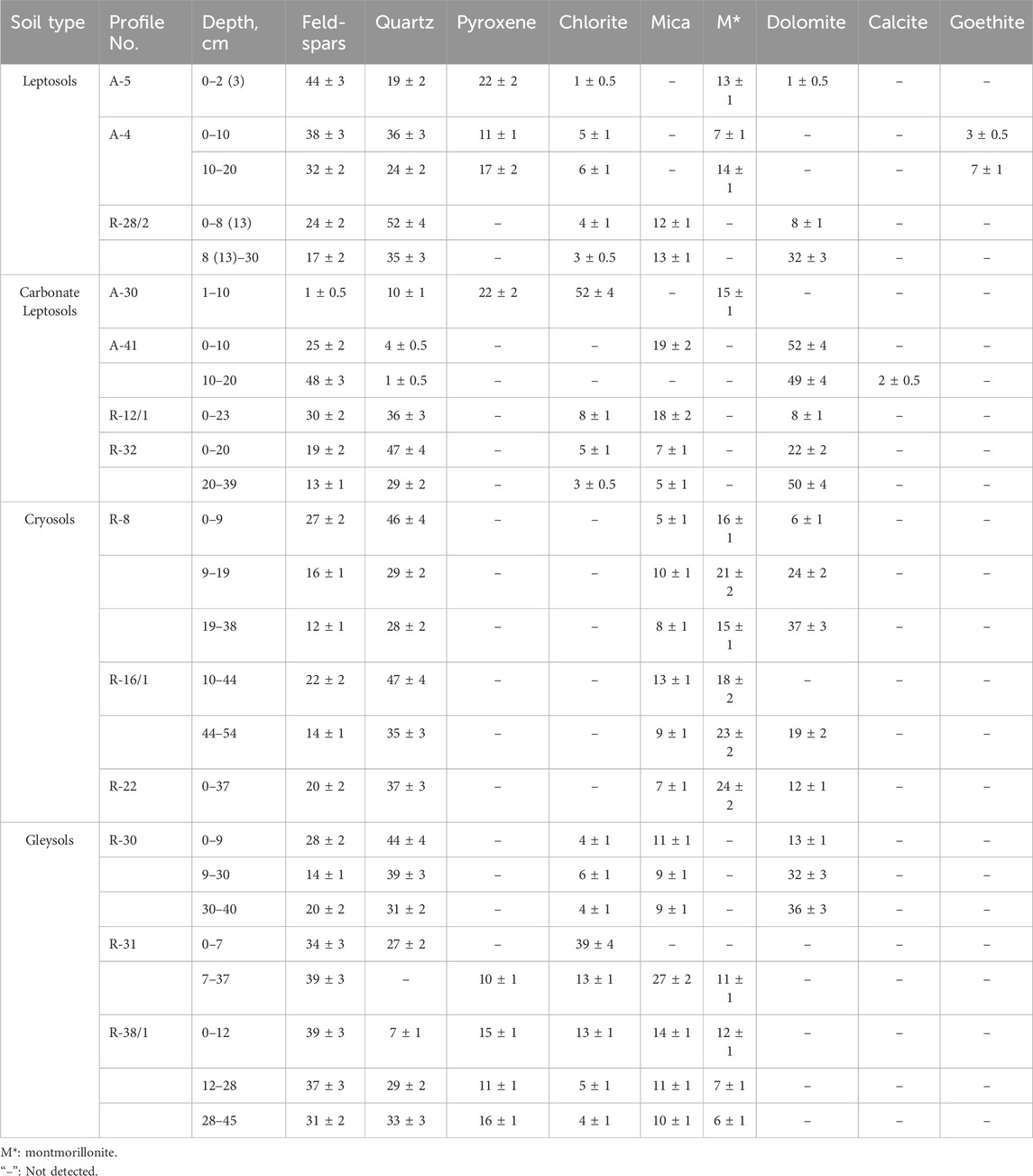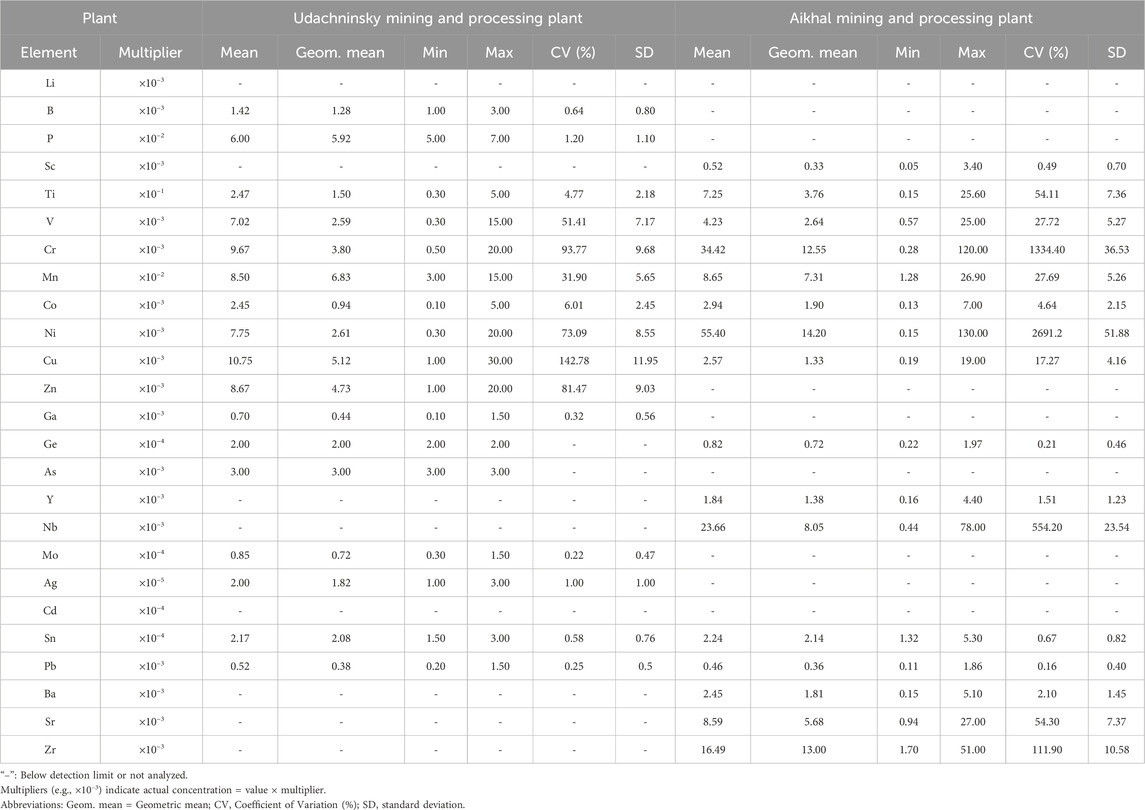- 1Laboratory of Geoecology and Biogeochemistry, Diamond and Precious Metals Geology Institute, Siberian Branch Russia Academia Science, Yakutsk, Russia
- 2Laboratory of Petrology and Metallogeny, Diamond and Precious Metals Geology Institute, Siberian Branch Russia Academia Science, Yakutsk, Russia
Introduction: Mining in the Arctic induces severe environmental transformations, particularly soil salinization, which threatens the fragile ecosystems of permafrost-affected landscapes. This study investigates the mechanisms of this process in the Daldyn-Alakit region (Western Yakutia), focusing on the interaction between the geogenic potential of waste rocks and technogenic triggers.
Methods: We conducted an integrated analysis of technogenic massifs (waste rock dumps, tailings) and soils at the Udachninsky and Aikhal mining and processing plants. The methodology included petrographic microscopy, X-ray diffraction (XRD) analysis, geochemical analysis of major oxides and trace elements, and ion chromatography of water extracts to characterize salinity.
Results: We identified that gypsum-bearing dumps at the Aikhal site present a high inherent risk for sulfate salinization, while the kimberlites contribute primarily to trace metal (Ni, Cr) enrichment. However, the actual widespread salinization is driven by technogenic factors: the primary activator for chloride salinization is the surface interaction with highly mineralized brines from injection sites and tailings storage facilities. The secondary driver is the enhanced weathering of waste dumps, releasing sulfates.
Discussion: Our results demonstrate that salinization type is not a simple function of waste rock composition but a complex interplay between inherent geochemical properties and mining-induced pathways. This finding is crucial for developing targeted reclamation strategies.
1 Introduction
Man-made massifs formed as a result of mining activities are artificially created geological bodies within natural landscapes (Moseikin et al., 2013; Shengo, 2021; Vriens et al., 2020). These are complex systems consisting of fragments of host and overlying rocks, which can have a significant impact on ecosystem dynamics (Yurkevich et al., 2021; Galchenko, 2007; Zinchuk, 2023; Bullock et al., 2021). Man-made massifs formed during the extraction of minerals are one of the key environmental problems in the world’s mining regions. Their impact goes beyond local impact, leading to soil degradation (loss of fertility, salinization, heavy metal pollution), violation of the hydrological regime (changes in groundwater levels, flooding, formation of acidic drainage waters), biodiversity (vegetation death, animal migration) (Schoenberger, 2016; Yilmaz, 2011; Pijpers et al., 2021).
However, in the permafrost-affected regions, the specific mechanisms of soil salinization triggered by mining remain poorly understood. It is critical to distinguish between the inherent geogenic potential of the waste rocks to release salts upon weathering and the external technogenic drivers that activate this potential, such as the infiltration of highly mineralized drainage waters.
In the studied area, man-made massifs are represented by waste rock dumps, tailings storage facilities and drainage water injection sites and highly mineralized brines in the permafrost layer. As a result of the impact of man-made massifs on the environment, in addition to the mechanical disruption of the integrity of landscapes, ecosystems are geochemically transformed. Petrographic and mineralogical analysis of such massifs allows us to identify key mechanisms of their formation and transformation, and also predict the potential environmental consequences of their impact on the environment (Rusanov et al., 2002; Korchagina et al., 2019).
Our research focuses on the progressive soil salinization processes that have begun to occur in soils due to the development of primary diamond deposits. The development of these processes in the studied area is related to both the impact of highly mineralized waters and the influence of waste rock dumps, as a result, toxic salts accumulate in the soil cover, which generally leads to the degradation of ecosystems. In the conditions of the northern taiga, where biological activity and soil capability are initially low, such processes can have long-term negative consequences (Shadrinova, 2024; Legostaeva et al., 2018). This study posits that the mineralogical composition of mining wastes (e.g., the presence of soluble minerals like gypsum) defines the latent risk of salinization (e.g., sulfate vs. chloride types), while the hydrogeological conditions and mining practices (e.g., brine discharge) act as the activating mechanism. Consequently, a comprehensive analysis, spanning from the detailed petrology of the waste to the chemistry of soil solutions, is essential to unravel the complex causality of salinization in these fragile ecosystems.
The aim of this study is to assess the impact of technogenic massifs on the transformation of the mineralogical and geochemical composition of soils in the Daldyn-Alakit diamond-bearing region and identify the causes of the development of soil salinization processes in northern taiga landscapes by conducting fully characterizing the mineralogical and geochemical composition of the major mining wastes.
2 Objects and methods
2.1 Characteristics of the territory
The research was conducted in the Western Yakutia in the territory of the Daldyn-Alakit diamond-bearing region 66°24′N, 112°17′E of the Yakut diamondiferous province (Figure 1).
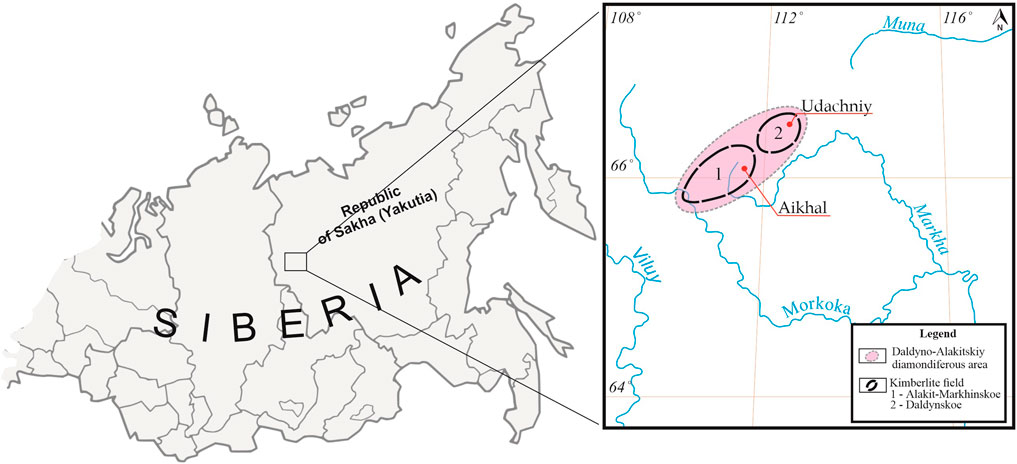
Figure 1. Location of the study area in the Daldyn-Alakit diamond-bearing region, North-West Yakutia.
The Daldyn-Alakit diamond-bearing region is a unique geological object, located in the central part of the Yakut diamondiferous province at the junction of the northeastern margin of the Tunguska syneclise with the Anabar anteclise (Afanasiev et al., 2010; Kargin et al., 2011). In this area, kimberlite bodies form a discontinuous strip about 150 km long, extending in a north-eastern direction. More than 130 pipes and dikes are known, unevenly distributed (Kharkiv et al., 1998). They are concentrated within two areas: the Daldyn kimberlite field (DKF) is in the northeast, where the Udachninsky Mining and Processing Plant (UMPP) has been developing the Udachnaya kimberlite pipe since 1971, and since 2000 – the Zarnitsa pipe. The Alakit-Markha kimberlite field (AMKF) is located in the central and southwestern parts of the region, where the Aikhal Mining and Processing Plant (AMPP) put five kimberlite pipes into operation from 1961 to 2023 – Yubileinaya, Aikhal, Sytykanskaya, Zarya and Komsomolskaya. Currently, underground mining is underway at the Udachnaya and Aikhal pipe quarries, and the Sytykanskaya and Komsomolskaya pipes have been completely exhausted and their quarries have been mothballed.
The research area is drained by three large watercourses: Markha, Daldyn and Alakit. In the Daldyn river basin in the northeast of the region, carbonate rocks of the Lower Ordovician and Upper Cambrian are widespread, represented by limestones, dolomites, claystones and marls. In the southwestern part, in the upper reaches of the Alakit and Markha rivers, variegated clay-carbonate deposits of the Middle Ordovician and limestones of the Lower Silurian predominate. In addition, the Upper Paleozoic terrigenous rocks are widely developed in this area. They include clay shales, siltstones and sandstones of the Middle-Upper Carboniferous and Lower and Upper Permian. All these Lower Paleozoic formations are intruded by numerous kimberlite pipes of the Middle Paleozoic age (Kharkiv et al., 1998).
The region is characterized by a sharply continental cryoarid climate, with negative average annual temperatures of −12 °С and continuous distribution of permafrost rocks (Shadrinova, 2024).
The combination of geological conditions and climatic factors determines the specificity of the soil-forming rocks of the region, which are distinguished by a complex composition with a significant influence of magmatic processes on the geochemistry of modern landscapes. Natural geochemical anomalies related to kimberlites, traps and deep faults, form the geochemical habit of the territory with the dominance of the Cr-Ni-Co component in the microelement composition of the soils (Legostaeva et al., 2023). Modern man-made landscapes (quarries, waste rock dumps, tailings storages, etc.), consisting of a mixture of rubble-block material and sandy-loam fractions, are sources of impact on the components of the natural landscape and, above all, on the soil cover, with the formation of man-made anomalies in the soil cover, which are distinguished by high-contrast variations of elements coherent with kimberlites with admixture of Zn, Mn, Pb, Cd and As.
2.2 Characteristics of research objects
The study focuses on soils from natural undisturbed landscapes and anthropogenic substrates from mining waste dumps at the industrial sites of the Daldyn-Alakit diamond-bearing region. Man-made massifs or formations are represented by dumps around quarries of developed diamond deposits and preserved “tails” of kimberlite enrichment - tailings storage facilities. The dumps are composed of rubble-block material from deposits hosting and overlying kimberlites with an admixture of argillo-arenaceous filler. Tailings–by sandy-loam fraction of kimberlites. Man-made formations overlap the Quaternary formations of various genesis and age. The area of distribution and thickness of man-made deposits directly depend on the size and depth of the quarries being developed (Legostaeva et al., 2017). For example, in the area of the Aikhal deposit, the thickness of man-made deposits on waste rock dumps reaches 40 m (Figure 2). And on the right slope of the Daldyn River valley, where the Udachnaya pipe quarry is located, there are dumps of rocks containing kimberlites: Severny (occupies an area of 238 ha and has a height of 125 m), Zapadny (272 ha, height 125 m) and Yuzhny (70 ha, height 85 m). Their absolute marks are 420 m, 455 m and 425 m respectively.
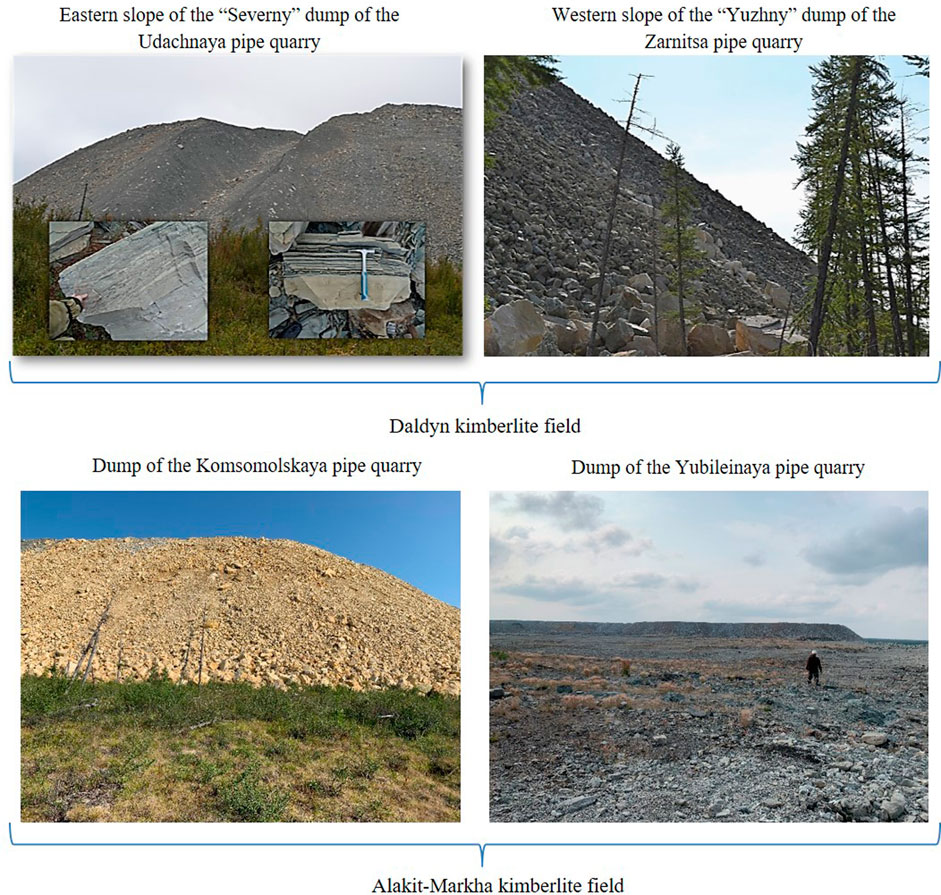
Figure 2. Onshore man-made storage facilities of the Daldyn-Alakit diamond mining region. Photos by Legostayeva Ya.B., Shadrinova O.V.
In general, waste rock dumps and tailings storages are man-made deposits, which, on the one hand, may be potential mineral deposits, or deposits with a high content of a wide range of elements, on the other hand, it is a permanent and long-term source of secondary pollution of adjacent territories. We have considered the assessment of the degree of impact of man-made massifs on ecosystem components based on the analysis of the ecological and geochemical state of the soil cover of industrial sites themselves with an assessment of the geoecological state of the territories, and the development of soil salinization processes in technogenically transformed landscapes is considered as an indicator of the manifestation of technogenic impact.
2.3 Research methods
The selection and sample preparation of soils were carried out in accordance with ISO 18400-8 (2018), the main oxides (SiO2, Al2O3, Fe2O3, etc.) were determined using classical methods of silicate analysis, including gravimetric, spectrophotometric, and titrimetric techniques following established handbooks (Arinushkina, 1970; Vozbutskaya, 1968; PND F 16.1.42-04, 2016). The content of the main anions and cations was determined in an water extract with a soil to water ratio of 1:5 according to GOST 26423-85 (1985); carbonate and bicarbonate anions (CO32–, HCO3–) were determined by titration with hydrochloric acid (HCl) using a potentiometric endpoint (GOST 26423-85, 1985); sulfate anions (SO42–) were analyzed turbidimetrically by precipitation with barium chloride (BaCl2); chloride anions (Cl−) were quantified by argentometric titration (Mohr’s method) in accordance with GOST 26425-85 (1985); water-soluble calcium (Ca2+) and magnesium (Mg2+) cations were measured by complexometric titration with Trilon B (EDTA) (GOST 26428-85, 1985); water-soluble sodium Na+ and potassium K+ cations were calculated from the difference between the total sum of anions and the sum of measured cations, a standard ion balance method (GOST 26426-85, 1985). The assessment of the chemistry and degree of salinity of soils and grounds was carried out based on the sum of toxic salts based on the results of water extract (Bazilevich and Pankova, 1968; 1972; GOST R 59540, 2021). The mineralogical composition was studied by petrographic (on a polarizing microscope–МТ9430L, MEIJI TECHNO CO., LTD., Japan) and X-ray phase (on a diffractometer D2 PHASER) methods of analysis. Semi-quantitative mineralogical composition was calculated using peak intensity comparison with reference data using the RIR method (Reference Intensity Ratio) taking into account the elemental composition to adjust the proportions of minerals. The elemental composition of gallstones was analyzed using semi-quantitative atomic emission spectroscopy (MAES, “VMK-Optoelectronics,” Russia). Powdered samples were atomized using an electrothermal sprayer with a graphite rod, and the resulting spectral lines were evaluated visually. Among 32 analyzed elements (Au, Ta, Sb, Ga, W, Cr, Ge, Ba, Be, Nb, Sn, V, Mo, Li, La, In, Sc, Yb, Y, Ag, Co, Sr), concentrations were below the detection limit The map-schemes of the areal distribution of soil salinity were constructed in the Surfer-13 software package using the “kriging” interpolation method.
The data were processed using descriptive statistics. The results are presented as the arithmetic mean (Mean), minimum and maximum values (Min, Max), standard deviation (Std. Dev.), and coefficient of variation (CV, %) to characterize the central tendency and variability of the obtained datasets.
3 Results and discussion
3.1 Petrographic analysis, mineralogical and chemical composition of sedimentary rocks in man-made massifs
Our integrated analysis reveals a clear disconnect between the geogenic salinization potential and the actual technogenic factors controlling its expression, as unequivocally demonstrated by petrological data from sedimentary and igneous rocks.
Man-made massifs on the industrial sites of the Udachninsky and Aikhal mining and processing plants are composed of sedimentary rock fragments, mainly limestone, dolomite and gypsum. The Udachninskaya site is dominated by brown and grey limestones with a massive structure, as well as milky-white varieties with inclusions of plant remains, probably algae. The algae are composed of dark grey pelitomorphic carbonate against a background of light fine-grained calcite (Figure 3a). Dolomites are mostly marbled, have a banded texture and fine-grained structure, less often–a massive structure (Figures 3b,c). Their color range varies from gray and brownish-gray to green with yellowish-brown lenses. There are also yellowish-gray fine-grained sandstones with a banded texture.

Figure 3. Marbled limestone (a) with traces of plant remains from the dumps of the Udachnaya pipe quarry, dolomite from the dumps of the Zarnitsa pipe quarry (b) and the Udachnaya pipe (c), nicols crossed.
At the Aikhal site, brownish and grayish limestones are also characterized by a massive structure, and dolomites are brownish-gray. The composition of the dolomites at both sites includes carbonates and insoluble mineral residue (quartz, mica, feldspars, clinochlore – 2%). The petrographic study was confirmed by the results of semi-quantitative X-ray phase analysis (Table 1). The vast majority of samples are represented by carbonate rocks: limestones, dolomites and calcareous sandstones. The phase-mineral composition of limestones and dolomites includes carbonates and insoluble mineral residue. X-ray phase analysis revealed that limestones contain small admixtures of dolomite, and dolomites contain small admixtures of calcite. The exception is three samples (numbers P1, P3 and P4), where the insoluble mineral residue is represented by quartz, feldspars and mica. Clinochlore was found in four samples (numbers P1, P4, P5 and P9) (between 2.27% and 9.06%).
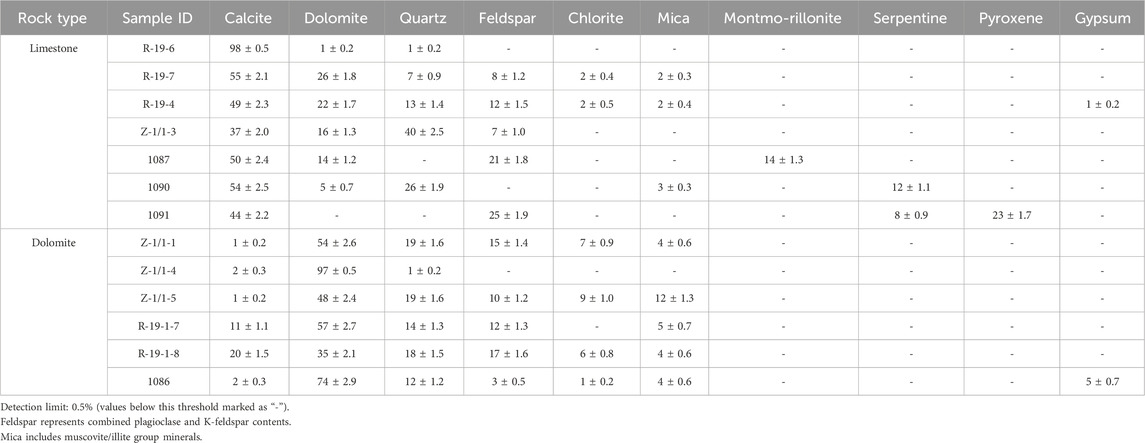
Table 1. Mineral content (% ± SD) in sedimentary rocks of the Daldyn-Alakit diamond-bearing region according to semi-quantitative X-ray phase analysis.
The chemical composition of rocks clearly reflects the mineral composition of carbonates and insoluble mineral residues. Oxides of silicon, titanium, aluminum, iron, potassium and sodium characterize the insoluble mineral residue, and oxides of calcium, magnesium, manganese and iron oxide characterize the carbonate component.
Samples from the empty dumps of the Udachninsky mining and processing plant are predominantly represented by clayey carbonate rocks, in particular calcite-bearing clayey dolomite and dolomite-bearing clayey limestone. Samples from the dumps of the Aikhal mining and processing plant are, as a rule, marls described as calcite-bearing dolomite, calcite dolomite, calcareous dolomite. The clay rocks record dolomite-bearing clayey limestone (sample number 3371) and dolomite clayey limestone (samples numbers 3346, 3348), and the marls record calcareous dolomite (sample P-19-4), calcite dolomite (samples P-19-1-7 and P-19-1-8), low-magnesite dolomite (sample 3-1/1-5) and magnesite-bearing dolomite (sample 3-1/1-1) marls. In some samples, clinochlore was detected, which, as a phyllosilicate, is a mineral of metamorphic processes, and its presence in marls explains their marbling.
The identified types of carbonate rocks differ petrochemically (Table 2). Marls in both the quarry dumps of the Aikhal mining and processing plant and the quarry dumps of the Udachninsky mining and processing plant are distinguished by an increased content of silica (between 23.88% and 34.24%) and alumina (between 3.26% and 8.28%), which in general defines the difference from clayey carbonate rocks. The content of potassium oxide in marls (between 1.54% and 1.74%) significantly exceeds the content of this oxide in clayey carbonate rocks, where it does not reach even one percent.
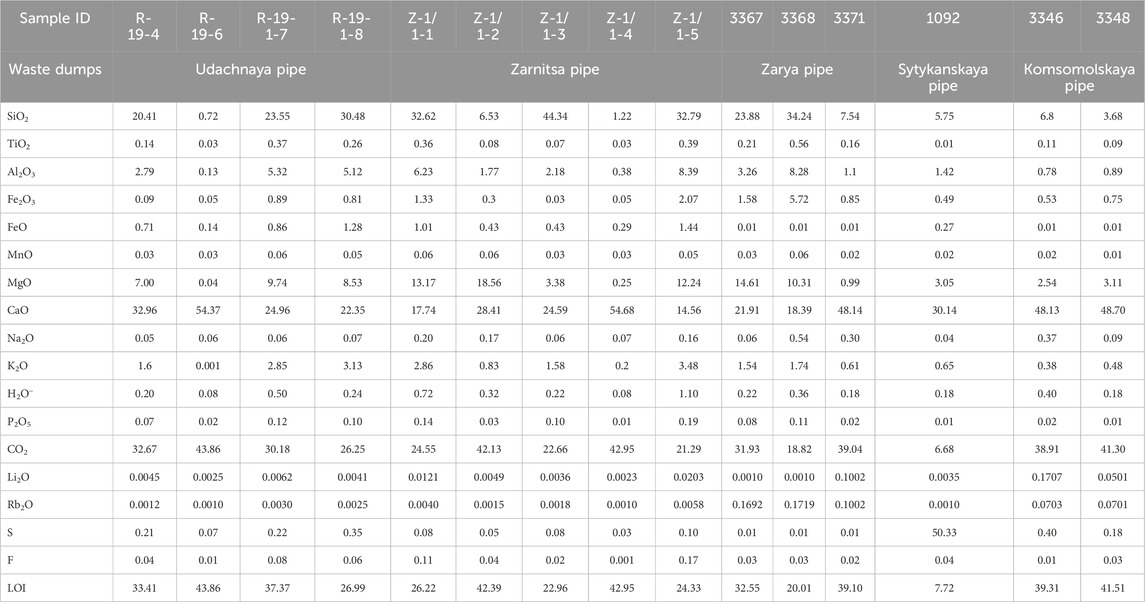
Table 2. Chemical composition of sedimentary rocks from quarry dumps of kimberlite pipes in the Daldyn-Alakit diamond-bearing region, wt.%.
Gypsum, found mainly in the dumps of the Komsomolskaya, Yubileynaya and Sytykanskaya pipes on the territory of the Aikhal site, differs from marls and clayey carbonate rocks by its increased sulfur content (50.33%), and the content of calcium oxide (30.14%) and magnesium oxide (3.05%) allows us to conclude that calcareous dolomite marls were the host rocks.
It is found in layers where the dolomite, inundation part is composed of gray, inequigranular dolomites with interlayers of stromatolitic, clayey and calcareous dolomites and dolomite marls with gypsum and anhydrite.
It should be noted that the change in the calcite content is inversely proportional to the dolomite content–with an increase in the first, the amount of the second decreases. The following common factor is observed for feldspars: potassium feldspar is present in limestones, the amount of sodium-calcium feldspars (plagioclases) is very insignificant or is below the sensitivity limit of the analysis method; plagioclase is present in dolomites, at the same time, on the contrary, the amount of potassium feldspar is very insignificant, or is below the sensitivity limit of the analysis method.
3.2 Petrographic analysis, mineralogical and chemical composition of igneous rocks in man-made massifs
Fragments of igneous rocks in the dumps are represented by dolerites and kimberlites (Figure 4). Dolerites have a massive and ophitic structure, composed of plagioclase (40%), pyroxene (25%), olivine (25%) and ore minerals (10%) (Figures 4b,f). Kimberlites have a massive, porphyry structure, contain up to 15% xenogenic material (carbonates) and 85% of the main mass (carbonate, phlogopite, serpentine, ore minerals) (Figures 4d,h).
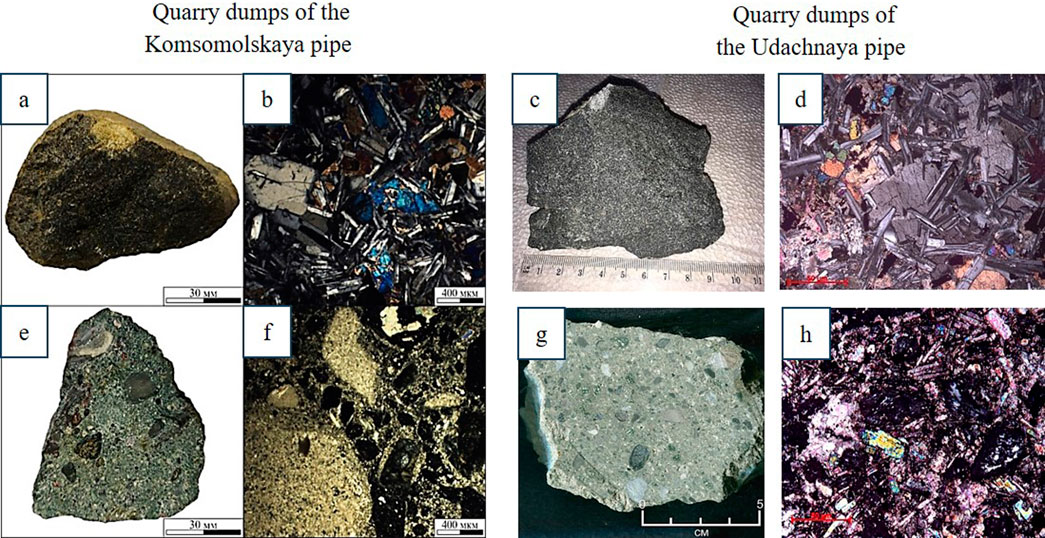
Figure 4. Igneous rocks from the dumps of the Komsomolskaya and Udachnaya quarries, dolerites (a,b,e,f) and kimberlites (c,d,g,h), nicols crossed.
Chemical analysis of two samples (3340 and 3347) of kimberlites in the dumps of the Komsomolskaya pipe quarry of the Aikhal mining and processing plant revealed characteristic features of the chemical composition (Table 3), reflecting the processes of secondary rock changes. The predominant components in all studied samples are silicon dioxide (between 48.32% and 48.63%) and aluminum oxide (between 15.24% and 16.33%), which is typical for silicate rocks. The significant content of iron oxide (between 11.20% and 12.21%) in the complete absence of iron oxide indicates the predominance of oxidized forms of iron, which is typical for weathered kimberlites. Variations in calcium oxide content between 11.37% and 14.18% may be due to uneven distribution of carbonate material in the dumps. Low magnesium oxide content (between 7.45% and 8.49%) and the presence of volatile components also indicate the influence of weathering processes in kimberlite rocks. Alkaline components are present in small quantities: sodium oxide (between 1.46% and 1.48%) and potassium oxide (between 0.22% and 0.26%), that corresponds to the typical geochemistry of kimberlites. The obtained data are consistent with the literature data on the composition of altered kimberlites and indicate a significant degree of their secondary transformation (Zinchuk, 2021). It should be noted that the high content of iron oxide and calcium oxide in the soils and rocks of the Aikhal mining and processing plant dumps may affect the salt balance of adjacent soils, which in turn is not found in the rocks of the Udachninsky mining and processing plant waste dumps.
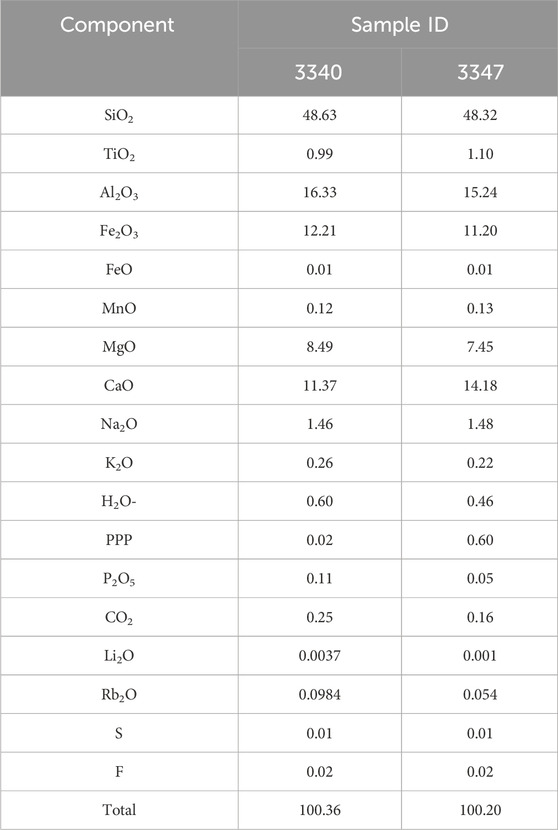
Table 3. Chemical composition of kimberlites from quarry dumps of the Komsomolskaya pipe of Aikhal mining and processing plant, wt.%.
The conclusions obtained during the petrographic study are confirmed by the results of semi-quantitative X-ray phase analysis (Table 4). The variation in the amount of minerals in the composition of dolerites is as follows: plagioclase between 47% and 69%, pyroxene between 23% and 33%, ilmenite between 7% and 12%, montmorillonite group minerals between 1% and 5%, quartz between 1% and 3%, chlorite group minerals about 3%, mica about 7%, olivine, amphibole and talc are present in minor quantities.

Table 4. Mineral composition (% ± SD) of kimberlites based on semi-quantitative X-ray phase analysis.
A set of methods used in the analysis of the structural and material composition of man-made formations allows us to conclude that dumps are composed of rubble and block material of rocks containing and overlying kimberlite pipes), consisting mainly of limestones and dolomites, with wide variation in quartz content, while the amount of feldspars and layered silicates varies within only 10%.
The dumps are composed of limestone and dolomite on the surface, but gypsum is present in the dumps of the Komsomolskaya, Yubileynaya and Sytykanskaya pipes of the Aikhal industrial site. The predominance of serpentine and carbonates in kimberlites is noted, which probably indicates that the kimberlite grounmass is substantially altered, namely, serpentinized and carbonated.
3.3 Trace element composition of rocks of technogenic massifs
Average characteristics of geochemical features of rocks in dumps can be the basis for assessment when identifying any differences (Table 5). The prevalence of elements is adopted according to Vinogradov (1988).
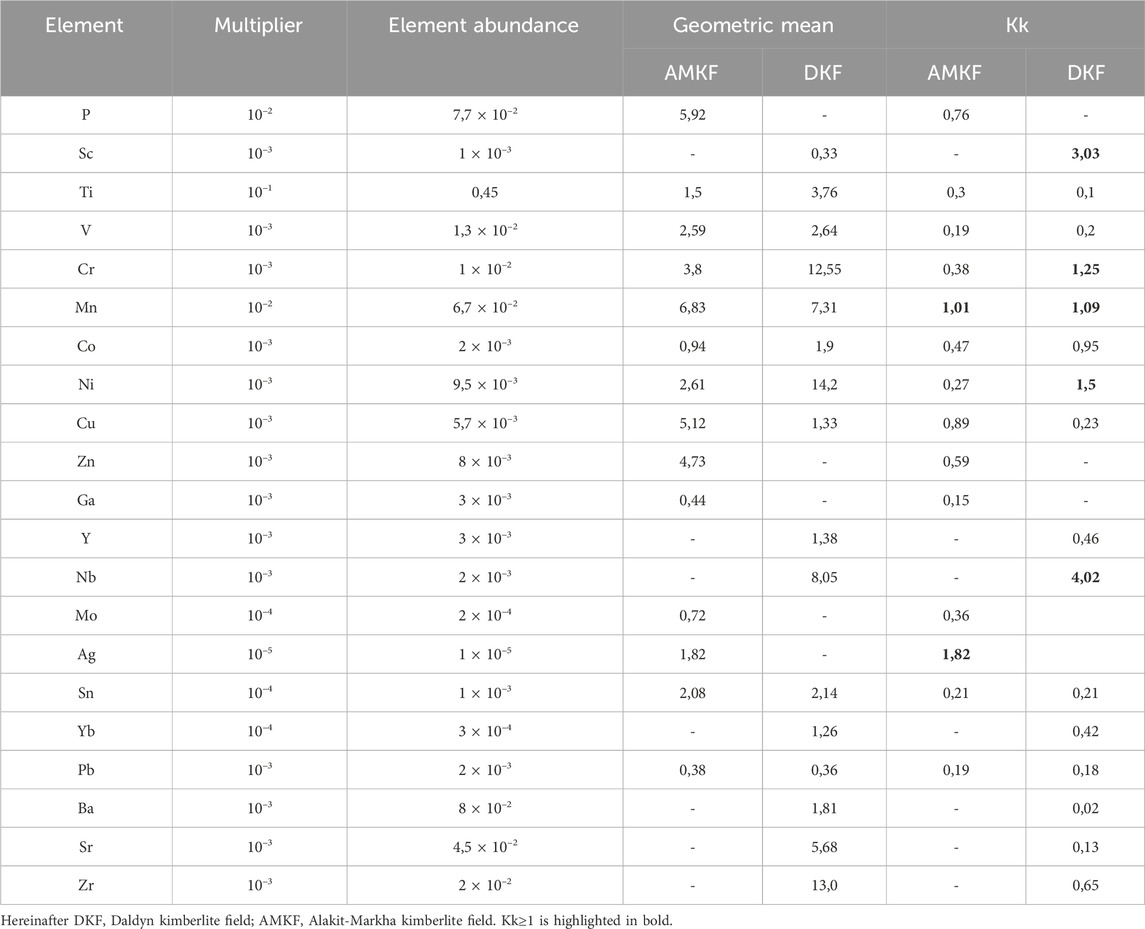
Table 5. Comparison of average trace element contents in waste dumps of the Daldyn-Alakit diamond-bearing region.
Based on the clarkes, the rocks in the dumps are distinguished by the uniqueness of their trace element spectra:
• DKF - Nb 4,02→ Sc 3,03 →Ni 1,5 →Cr 1,25→ Mn 1,09,
• AMKF - Ag 1,82 →Mn 1,01.
The given geochemical assessment is somewhat conditional, but it is quite acceptable for a general characterization. The composition of the trace element spectra shows the dominance of dolerites on the surface of the dumps.
The discovery of gypsum in the waste dumps of the Aikhal site (Komsomolskaya, Yubileynaya pipes) identifies them as a definitive potential source for sulfate-type salinization. In contrast, the kimberlites themselves, while enriched in a range of trace elements (Table 5), are dominated by silicate and carbonate minerals (e.g., serpentine, calcite) with low solubility in the cold Arctic climate. As our data on water-soluble salts confirm, their weathering alone is unlikely to cause significant soil salinization under natural conditions but contributes strongly to the trace metal load (e.g., Ni, Cr).
3.4 Soils of the Daldyn-Alakit diamond-bearing region, some of their physical properties and mineralogical composition
In the soil cover, cryosols (hereinafter: Cryosols according to the WRB classification) occupy 40.7%. Permafrost alluvial soils (Fluvisols) are an intrazonal type and are located on 19.4% of the area within the territory. Coarse-humic leptosols (Leptosols Skeletic (Humic)) and coarse-humic carbo-leptosols (Rendzin Leptosols (Humic)) - mountain primitive soils occupy a subordinate position in the structure of the soil cover and are formed in the upper parts of gentle slopes. All diagnosed soils belong to the postlithogenic group (Shishov et al., 2004; Dokuchaev Soil Science Inst, 2008). The soils are characterized by shallow profile, high rubble content, heavy granulometric composition, weak differentiation of the soil profile, which thickness on average reaches 30 cm with signs of thixotropy and cryoturbation mixing. For zonal loamy soils of watersheds, the average temperature for three summer months (June-August) at a depth of 20 cm varies between 0.1 and 3.6 °C–3.9 °C (Fedorov-Davydov et al., 2018). The lower soil horizons are usually frozen even in the summer months.
The lower horizons of C or CRM soils are usually frozen even during the summer months. The content of hygroscopic moisture varies from zero point ninety-eight hundredths to three-point fifteen hundredths percent depending on the depth of the horizons and the content of coarse-humic organic matter. The pH values in the studied soils varied from acidic to alkaline–from four point three to eight point seven (Table 6). Most soil samples are characterized by an alkaline pH reaction, their share is seventy percent, about fifteen percent of soil samples are characterized by a neutral pH reaction. The organic matter content is quite high, which is typical for soils in the northern regions and is associated with poor decomposition of organic matter.
Soils are usually characterized by a heavy granulometric composition with a predominance of finely dispersed fractions. Clay fractions have the highest sorption capacity and can accumulate the groundmass of micro- and macroelements.
Table 7 presents the results of the chemical composition analysis of the studied soils. The main parameters include the content of major oxides (SiO2, Al2O3, Fe2O3, CaO, MgO, Na2O, K2O, TiO2, MnO), volatile components (H2O−, P2O5, CO2), trace elements (Li2O, Rb2O) and total sulfur. The relatively low average SiO2 values (40%–55%) reflect the medium loamy composition of the studied soils. Overall, there is a noticeable decrease in Si, Al, and Fe oxides upward through the soil profile, indicating the predominance of the organogenic fraction. Similarly, the total content of calcium and magnesium oxides consistently decreases in the upper soil layers compared to the parent material.
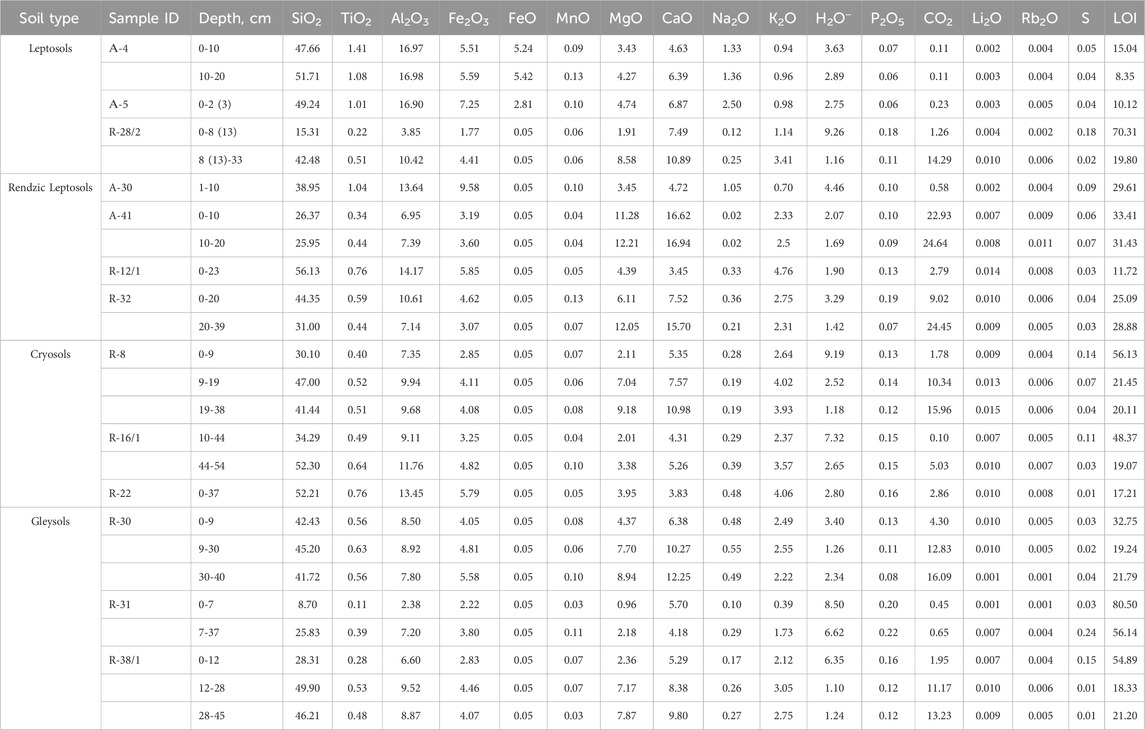
Table 7. Chemical composition of sedimentary rocks from quarry dumps of kimberlite pipes in the Daldyn-Alakit diamond-bearing region, wt.%.
The mineralogical composition of soils is given in general for zonal soil types, formed within the conventional boundaries of the Daldyn and Alakit-Markha kimberlite fields. The mineral composition of the studied soil types is almost identical.
The mineralogical composition of the soils is generally characteristic of zonal soil types formed within the conventional boundaries of the Daldyn and Alakit-Markha kimberlite fields. The mineral composition of the studied soil types is virtually identical.
It is natural that the mineralogical composition of the soil is mainly inherited from the parent rock. The main minerals of all soils are quartz, feldspars and dolomite; calcite was identified only in Rendzic Leptosols. Next aluminosilicates come, their composition is quite uniform and is represented by minerals from the group of micas, chlorites and minerals with a labile lattice. Pyroxene is present in leptosols. The content of dolomite, feldspars and minerals of the chlorite and mica group decreases from bottom to top along the profile (Table 8), which indicates heritability from rocks and weak transformation in the soil profile. This mechanism is typical for cryogenic landscapes, where low temperatures and a short growing season slow down the processes of chemical weathering and clay formation.
3.5 Trace element characteristics of soils of industrial sites
Trace element characteristics of soils of the Daldyn and Alakit-Markha kimberlite fields are given in Table 9. The average concentrations of trace elements in the soils of the Daldyn kimberlite field decrease in the following order: Ni > Mn > Cr > Li > Zn > V > P > Ti, etc. Among them, the contents of Ni, Cr, Co, As, Mn exceeded background values by 4.93, 2.09, 1.72, 1.69 and 1.65 times, respectively. The coefficient of variation (CV) reflects the average variation of element concentrations, while CV > 35% reflects a high level of oscillations, 15% < CV < 35% is a moderate level of variation, and CV ≤ 15% – low variability (Wang et al., 2019; Abliz et al., 2023). In this study, the CV of Ni, Cr and P accounted for more than 35%, which indicates high fluctuations in values. 42% of the values are characterized by low variation, and Li, V, Mn and Zn have more uniform values.
The results of the study of the trace element composition of soils at the industrial site of the Udachninsky mining and processing plant revealed significant differences in the distribution of heavy metals compared to regional and local background values (Table 9). Data analysis demonstrates a pronounced man-made transformation of the soil cover, manifested in changes in both the gross content and mobility of trace elements. The most significant changes are noticeable for chromium, which content in industrial soils (107 mg/kg) exceeds both regional background values (80.6 mg/kg) and the indicators of undisturbed areas (63 mg/kg). At the same time, the mobility of chromium remains extremely low (1.1%–5.0%), which is typical for its stable forms in the soil environment. A similar trend is observed for nickel, which concentration at the industrial site (63 mg/kg) is significantly higher than the regional background (38 mg/kg), however, its mobility rate has been reduced to 6.2% against the regional average of 23.6%. The behavior of lead deserves special attention, demonstrating not only an increase in the gross content in industrial soils (10 mg/kg versus 5.6 mg/kg in the local background), but also abnormally high mobility rates (100.7% in regional data), which requires additional verification of the results obtained. Zinc also shows an increase in content in the zone of technogenic impact (70.3 mg/kg) relative to the regional background (54 mg/kg) with some decrease in mobility (13.0% versus 18.4%). Copper is characterized by relative stability of gross content (27.1–32 mg/kg) while maintaining a high degree of mobility at the level of 25%–25.5%, which is due to its ability to form complex compounds with soil organic matter. Manganese, despite the decrease in its total content in industrial soils (560 mg/kg) compared to the regional background (1030 mg/kg), retains high mobility (34.7%–34.9%), which is explained by its active participation in redox processes. The obtained results indicate a significant man-made impact on the soil cover in the area of the industrial site of the Udachninsky mining and processing plant, expressed in the accumulation of a number of heavy metals (Cr, Ni, Pb, Zn) with a change in their migration capacity.
Thus, the soils of the Daldyn and Alakit-Markha kimberlite fields reflect the characteristics of the soil-forming rocks and climatic conditions of the region, which is confirmed by their mineralogical composition. The mineralogical composition of soils represented mainly by silicate and carbonate associations, plays a key role in soil formation processes. In cryolithozone conditions these mineral groups, having limited solubility at low temperatures, do not contribute to the development of salinization processes. As is known, in extreme northern conditions, physical weathering of the mineral matrix prevails over chemical weathering. In this regard, a geoecological assessment of the state of the territories of industrial sites of mining and processing plants of the Daldyn-Alakit diamond-bearing region was carried out on the technogenically transformed territory of industrial sites of mining and processing plants. This assessment was based on the interpretation of the results of the water-soluble salt dynamics analysis as an indicator of technogenic impact on soil cover and soil-like formations.
The surface cover of technogenically transformed landscapes of industrial sites is a motley pedonic complex with disturbed internal relationships of natural mechanisms of intra-profile distribution of matter. In addition to the remaining small areas with natural soil and vegetation cover with undisturbed soil profile morphology, anthropogenically modified soils have been formed–these are soils “preserved” by man-made embankments, dumps or a layer of spilled pulp, covering a completely preserved natural appearance of the soil profile. Most of the territory of industrial sites is occupied by man-made surface formations (MSF), represented by the lithostrats–waste dump soils with signs of primary soil formation, and toxilithostrats–soils on the beaches of tailings storage facilities, consisting of fine- and medium-grained material from waste pulp, often with the beginnings of ruderal vegetation development along the periphery of the sites (or the beach of tailings).
3.6 Characteristics of the cation-anion complex and the development of soil salinization processes
In the natural landscapes of the Daldyn-Alakit diamond-bearing region outside the zone of technogenic impact, the cation-anion composition of soils is characterized by the following series: Ca2+, Cl− > HCO3− > Mg2+ > Na+,K+ > SO42− and a complete absence of salinization processes. The background soils contain non-toxic salts such as Ca(HCO3)2 and CaSO4, toxic salts are absent or are present in concentrations below the toxicity limit values (Figure 5A).

Figure 5. Toxic salts sum range diagram (%) in natural soils of the Daldyn-Alakit diamon-bearing region (A) and industrial sites of AMPP (B) and UMPP (C).
At the same time, the development of area soil salinization can be observed at the industrial sites of both mining and processing plants, which is especially evident in the area of impact of man-made storage facilities.
In the soils of the industrial site of the Udachninsky mining and processing plant with occurrence of salinization processes from weak to moderate degree, a uniform increase of all ions is noticeable, and in soils with a strong and very strong degree, a sharp increase of Cl− and Na+ and K+is recorded. The soils of the industrial site of the Udachnaya pipe are distinguished by a large range of toxic salts. In 2012, a highly mineralized water discharge was discovered on the territory of the “Kiengsky” injection site (Legostaeva et al., 2018). According to the analysis results, high values of chlorides and sodium, and, accordingly, the degree of salinization, are observed at the points of their outcrop. In addition, high salt contents are recorded in soils near tailings storage facilities and waste dumps both at the AMPP and UMPP sites (Figures 5B,C).
The qualitative composition of toxic salts is characterized by the presence of toxic salts MgCl2 and NaCl in all saline samples and CaCl2 in more than half of the samples. Their concentration in highly and very highly saline soils in relation to slightly saline samples increases by more than 11, 44 and 25 times, respectively (Table 10). The entire area is characterized by a predominantly chloride type of salinization.
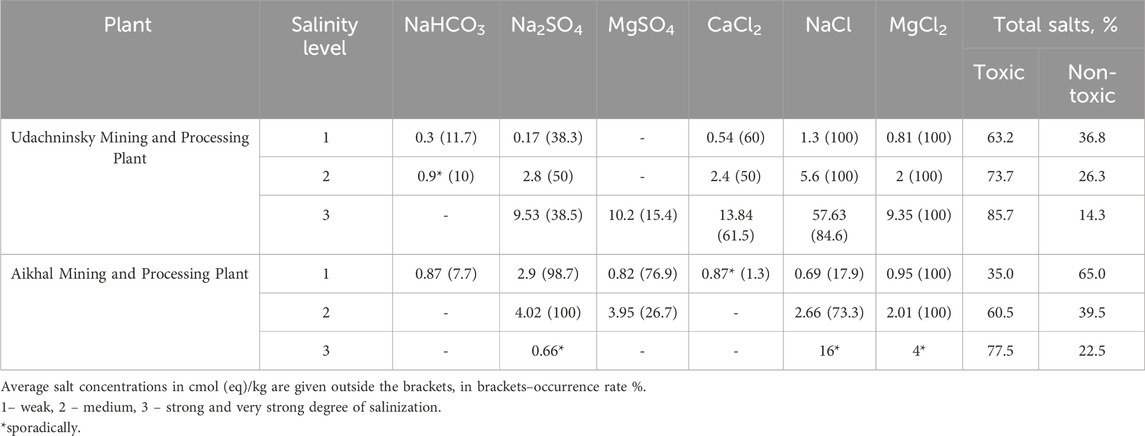
Table 10. Toxic salt composition and their occurrence frequency coefficient in soils of kimberlite fields.
In the soils of the industrial site of the AMPP with the occurrence of halogenesis processes, an increase in the content of almost all water-soluble ions except hydrocarbonates is recorded. In soils with a low degree of salinity, a sharp increase in sulfates and sodium is visible, chloride values remain virtually unchanged, soils are characterized mainly by chloride-sulphate, sulphate, less often - sulphate-chloride type. In soils with an average degree of salinity, a sharp increase in chloride content is recorded and they are characterized by a chloride, sulfate-chloride type. One point with a high degree of chloride type salinity was identified on the territory of the AMPP–on the territory of the Komsomolskaya pipe, where an emergency spill of the reinjection water pipeline occurred (Figure 6).
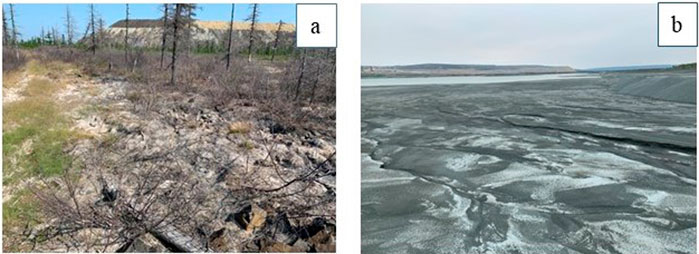
Figure 6. An area of high chloride salinity in the Komsomolskaya pipe area (a). Chloride salt outcrops on the beach area of the tailing storage facilities of the processing plant No. 8 of the AMPP (b). Photos by Shadrinova O.V.
Na2SO4 and MgCl2 are commonly present in toxic salts (Table 10). As the degree of salinity increases, the NaCl content increases. The maximum values of the sum of toxic salts reach 0.8%.
In general, in the territory of the Daldyn-Alakit diamond-bearing region, the development of technogenic salinization processes has acquired an area character (Figure 7). On the territory of the UMPP, a more intensive process of development of salinization of the predominantly chloride type is observed. The qualitative composition is dominated by toxic chloride salts: MgCl2, NaCl and CaCl2. Salts dominate in the soils and grounds on the territory of the AMPP: Na2SO4 and MgCl2 and NaCl. Increased concentrations of chlorides are observed in the impact zone of tailings storage facilities, where, according to (Yannikov et al., 2022), chloride brines with a concentration of up to 60 g/L are buried.
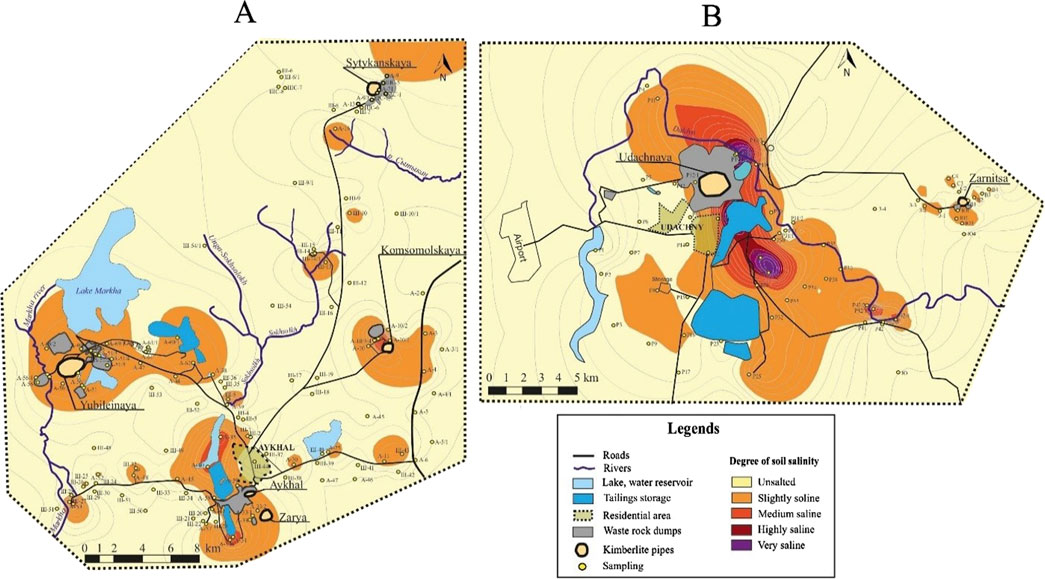
Figure 7. Scheme of the area distribution of soil salinization processes on the territory of industrial sites of AMPP (A) and UMPP (B).
The development of kimberlite pipes in the Yakutian diamond province is complicated by the presence of highly mineralized brines. As the quarry depth increases, the volume of brines flowing into it also increases. These highly mineralized waters are pumped to the surface and stored in both underground and surface technogenic storage facilities, which have a direct impact on the adjacent territory.
Currently, the natural brine inflow is 300–350 m3/day at the Udachnaya pipe, 120–150 m3/day at the Aikhal mine, and 10–20 m3/day at the Yubileynaya pipe. Further mining operations plan to increase the depth of the pipes: Aikhal - up to 1,100 m, Yubileynaya - up to 900 or 1,500 m, and Udachnaya - to a depth of 1,830 m (Yannikov et al., 2024). This will undoubtedly lead to an increase in the inflow of highly mineralized brines (Yannikov et al., 2021) and the volume of waste. Consequently, an activation of surface salinization processes can be expected in areas within the impact zone of tailings storage facilities and waste rock dumps.
The territory of the Daldyn kimberlite field is characterized by larger volumes of brines compared to the Alakit-Markha kimberlite field. In general, the predominance of the chloride type of salinization in the soils at the Udachninsky MPP site is due to a complex hydrogeological situation and the indirect influence of highly mineralized brines. In contrast, the territory of the Aikhal MPP exhibits predominantly sulfate and chloride-sulfate types of soil salinization, which is caused primarily by the impact of waste dumps characterized by a diverse composition.
This latent geogenic potential is activated almost exclusively by external technogenic factors. The data presented in Figures X and Y provide compelling evidence that the primary activator for chloride-type salinization is the infiltration and surface runoff of highly mineralized brines from drainage water injection sites and tailings storage facilities. This explains the stark contrast between the two sites: the predominance of chloride salinity at the Udachninsky site is linked to its complex hydrogeology and brine management practices, while the sulfate-chloride types at the Aikhal site are triggered by the combined impact of brine discharge and the active weathering of gypsum-bearing dumps.
Thus, the spatial patterns of salinization are not a simple function of the waste rock composition but a complex interplay between this inherent potential and the specific mining-induced pathways of solute transport.
4 Conclusion
The soils of the Daldyn-Alakit diamond-bearing region are formed under the influence of the geological and geochemical specific matter of the soil-forming rocks and harsh climatic conditions. Their mineralogical composition, represented mainly by quartz, feldspars and dolomite, indicates the stability of the ecosystem in undisturbed landscapes. In cryolithozone conditions, the low solubility of these minerals at subzero temperatures limits the entry of salts into the soil solution, which is confirmed by the data of the analysis of water extracts.
The mineralogical and geochemical composition of mining wastes defines the inherent potential for environmental impact: gypsum-bearing dumps at the Aikhal site present a high risk of sulfate salinization, while the mineralogy of the kimberlites contributes primarily to trace metal (Ni, Cr) contamination rather than salinization.
The actual activation of this potential is driven by technogenic processes. The primary driver for widespread chloride salinization is the surface interaction of soils with highly mineralized drainage brines from injection sites and tailings storage facilities. The secondary driver is the enhanced weathering and dust generation from waste dumps, releasing sulfates and trace elements into the environment.
Consequently, the type and intensity of soil degradation are a result of the interplay between the waste material’s inherent properties and site-specific mining practices. This finding is crucial for developing targeted reclamation strategies: mitigating chloride salinization requires improved brine management, while controlling sulfate salinization and dust pollution demands covering and stabilizing the gypsum-bearing waste dumps.
Studies have shown that the content of basic cations (Na+, K+, Ca2+, Mg2+) and anions (Cl−, SO42−, HCO3−) in soils of natural landscapes does not exceed background values. However, in the technogenically transformed territories of the mining and processing plants of the Daldyn-Alakit diamond-bearing region, a change in the ionic composition is observed, related to industrial activities.
Thus, the study reveals important aspects of the interaction of soil cover with man-made formations, emphasizes the influence of climatic factors on soil formation and indicates the possibility of sustainable management of natural resources in the studied regions.
Data availability statement
The raw data supporting the conclusions of this article will be made available by the authors, without undue reservation.
Author contributions
TV: Conceptualization, Project administration, Supervision, Writing – original draft, Writing – review and editing. YL: Conceptualization, Supervision, Writing – review and editing. OS: Writing – review and editing. EI: Writing – review and editing.
Funding
The author(s) declare that financial support was received for the research and/or publication of this article. This study was conducted as part of the Russian Science Foundation Grant No. 24-27-20128, titled “Research, Identification, and Assessment of Potential Geoecological Risks of Environmental Pollution During Prospecting and Development of Mineral Deposits Under Extreme Continental Bioclimatic Conditions”.
Conflict of interest
The authors declare that the research was conducted in the absence of any commercial or financial relationships that could be construed as a potential conflict of interest.
Generative AI statement
The author(s) declare that no Generative AI was used in the creation of this manuscript.
Any alternative text (alt text) provided alongside figures in this article has been generated by Frontiers with the support of artificial intelligence and reasonable efforts have been made to ensure accuracy, including review by the authors wherever possible. If you identify any issues, please contact us.
Publisher’s note
All claims expressed in this article are solely those of the authors and do not necessarily represent those of their affiliated organizations, or those of the publisher, the editors and the reviewers. Any product that may be evaluated in this article, or claim that may be made by its manufacturer, is not guaranteed or endorsed by the publisher.
References
Abliz, A., Imin, B., and Asaiduli, H. (2023). Spatial patterns, possible sources, and risks assessment of soil potentially toxic elements in an open pit coal mining area in a typical arid region. Sustainability 15 (16), 12432. doi:10.3390/su151612432
Afanasiev, V. P., Zinchuk, N. N., and Koptil, V. I. (1998). Poligines of diamonds in connection nith the problem of primary placers of the north-cast of the Siberian platform. Reports of the Academy of Sciences. 361, 366–369.
Arinushkina, E. V. (1970). Guide to the chemical analysis of soils. Moscow: Moscow State University Press.
Bazilevich, N. I., and Pankova, E. I. (1968). Experience in classifying soils by salinity. Pochvovedenie. 11, 3–16.
Bazilevich, N. I., and Pankova, E. I. (1972). Experience in classifying soils by the content of toxic salts and ions. Byulleten Pochvennogo Instituta. 5, 36–42.
Bullock, L. A., James, R. H., Matter, J., Renforth, P., and Teagle, D. A. H. (2021). Global carbon dioxide removal potential of waste materials from metal and diamond mining. Front. Clim. 3, 694175. doi:10.3389/fclim.2021.694175
Dokuchaev Soil Science Inst (2008). Field guide for Russian soils. Moscow: Dokuchaev Soil Science Inst.
Fedorov-Davydov, D. G., Davydov, S. P., Davydova, A. I., Ostroumov, V. E., Kholodov, A. L., Sorokovikov, V. A., et al. (2018). Temperature regime of soils in northern Yakutia. Kriosf. Zemli 22 (4), 15–24. doi:10.21782/KZ1560-7496-2018-4(15-24)
Galchenko, Y. P. (2007). Dynamics of changes in the composition and state of biota elements in the zone of technogenic impact of mining enterprises. Gorn. Informatsionno-Analiticheskii Byulleten 11, 209–214.
GOST 26423-85 (1985). Soils. Methods for determination of specific electric conductivity, pH and solid residue of water extract. Moscow: Standartinform.
GOST 26425-85 (1985). Soils. Methods for Determination of chloride ions in water extract. Moscow: Standartinform.
GOST 26426-85 (1985). Soils. Methods for Determination of sulphate ions in water extract. Moscow: Standartinform.
GOST 26428-85 (1985). Soils. Methods for Determination of calcium and magnesium in water extract. Moscow: Standartinform.
GOST R 59540-2021 (2021). Soils. Methods for laboratory determination of salinity degree. Moscow: Standartinform.
ISO 18400-8 (2018). Soil quality – sampling – Part 8: guidance on sampling of stockpiles. Geneva, Switzerland: ISO.
Kargin, A. V., Golubeva, Y. Y., and Kononova, V. A. (2011). Kimberlites of the Daldyn-Alakit district (Yakutia): spatial distribution of rocks with different material characteristics. Petrologiya 19 (5), 520–545.
Kharkiv, A. D., Zinchuk, N. N., and Kryuchkov, A. I. (1998). Primary diamond deposits of the world. Moscow: Nedra.
Korchagina, T. V., Prokhorov, D. O., and Koryakov, A. E. (2019). Environmental status in regions of mining production. Izv. Tulskogo Gos. Univ. Nauki Zemle 4, 40–53.
Legostaeva, Y. B., Popov, V. F., and Ksenofontova, M. I. (2018). Hydrogeological conditions and geoecological situation in the area of underground technogenic storage facilities for the disposal of drainage brines of the Udachny Mining and Processing Plant. Otechestvennaya Geol. 5, 93–102. doi:10.24411/0869-7175-2018-10021
Legostaeva, Y. B., Gololobova, A. G., Popov, V. F., and Makarov, V. S. (2023). Geochemical properties and transformation of the microelement composition of soils during the development of primary diamond deposits in Yakutia. Zap. Gorn. Instituta 260, 212–225. doi:10.31897/pmi.2023.35
Moseikin, V. V., Galperin, A. M., Ermolov, V. A., and Krupolerov, V. S. (2013). Analysis of the situation with mining waste (geoecological aspects). Gorn. Informatsionno-Analiticheskii Byulleten S1, 7–23.
Pijpers, R. J., van de Camp, E., Fisher, E., Massaro, L., Calvimontes, J., D’Angelo, L., et al. (2021). Mining 'Waste': repurposing residues in artisanal and small-scale gold mining. Etnofoor 33 (2), 13–40.
PND F 16.1.42-04. (2016). Method for measuring the mass fraction of metals and metal oxides in powdered soil samples by X-ray fluorescence analysis.
Rusanov, A. M., Blokhin, E. V., Zenina, N. N., and Milyakova, E. A. (2002). Results of the study of soil pollution in the Orenburg region by heavy metals and radioactive elements. Vestn. Orenb. Gos. Univ. 1, 98–101.
Schoenberger, E. (2016). Environmentally sustainable mining: the case of tailings storage facilities. Resour. Policy 49, 119–128. doi:10.1016/j.resourpol.2016.04.009
Shadrinova, O. V. (2024). Analysis of climatic factors in the aspect of the development of salinization processes in soils of northern taiga landscapes. Vestn. Voronezhskogo Gos. Univ. Seriya Geogr. Geoekologiya. 2, 90–99. doi:10.17308/geo/1609-0683/2024/2/90-99
Shengo, L. M. (2021). Review of practices in the managements of mineral wastes: the case of waste rocks and mine tailings. Water Air Soil Pollut. 232, 273. doi:10.1007/s11270-021-05198-w
Shishov, L. L., Tonkonogov, V. D., Lebedeva, I. I., and Gerasimova, M. I. (2004). Classification and diagnostics of Russian soils. Smolensk. Oikumena.
Vinogradov, A. P. (1988). Problems of geochemistry and cosmochemistry. Selected works. Moscow: Nauka.
Vriens, B., Plante, B., Seigneur, N., and Jamieson, H. (2020). Mine waste rock: insights for sustainable hydrogeochemical management. Minerals 10 (9), 728. doi:10.3390/min10090728
Wang, M. S., Han, Q., Gui, C. L., Cao, J. L., Liu, Y. P., He, X. D., et al. (2019). Differences in the risk assessment of soil heavy metals between newly built and original parks in Jiaozuo, Henan Province, China. China. Sci. Total Environ. 676, 1–10. doi:10.1016/j.scitotenv.2019.03.396
Yannikov, A. M., Lepokurova, O. E., and Trifonov, N. S. (2021). Influence of faults on watering and gas content of deep horizons of the “Aykhal” pipe (Republic of Sakha (Yakutia)). Vestn. Voronezhskogo Gos. Univ. Seriya Geol. 1, 104–113. doi:10.17308/geology.2021.1/3342
Yannikov, A. M., Yannikova, S. A., Zyryanov, I. V., and Korepanov, A. Y. (2022). Prospects for the use of deep aquifers for injection of low-mineralized waters. Gorn. Promyshlennost 1, 76–81. doi:10.30686/1609-9192-2022-1-76-81
Yannikov, A. M., Zyryanov, I. V., and Korepanov, A. Y. (2024). Hydrogeological support of mining operations during the development of kimberlite deposits in the permafrost zone of Western Yakutia. Gorn. Informatsionno-Analiticheskii Byulleten 7, 169–179. doi:10.25018/0236_1493_2024_7_0_169
Yilmaz, E. (2011). Advances in reducing large volumes of environmentally harmful mine waste rocks and tailings. Gospod. Surowcami Miner., 89–112.
Yurkevich, N. V., Eltsov, I. N., Gureev, V. N., Mazov, N. A., and Edelev, A. V. (2021). Technogenic impact on the environment in the Russian Arctic on the example of the Norilsk industrial region. Izv. Tomsk. Politekhnicheskogo Univ. 332 (12), 230–249. doi:10.18799/24131830/2021/12/3207
Zinchuk, N. N. (2021). Specific features of postmagmatic and hypergene kimberlite rock alteration research. Otechestvennaya Geol. 5, 26–42. doi:10.47765/0869-7175-2021-10026
Keywords: mining waste, mine tailings, soil salinity, diamond mining, permafrost-affected soils, environmental pollution
Citation: Vasileva T, Legostaeva Y, Shadrinova O and Ivanov E (2025) The influence of diamond-mining industry waste on soil geochemistry and the development of salinization processes. Front. Environ. Sci. 13:1660339. doi: 10.3389/fenvs.2025.1660339
Received: 05 July 2025; Accepted: 09 September 2025;
Published: 01 October 2025.
Edited by:
Željka Fiket, Rudjer Boskovic Institute, CroatiaReviewed by:
Margarete Kalin, Boojum Research Ltd., CanadaKonstantin R. Frolov, Far Eastern Federal University, Russia
Copyright © 2025 Vasileva, Legostaeva, Shadrinova and Ivanov. This is an open-access article distributed under the terms of the Creative Commons Attribution License (CC BY). The use, distribution or reproduction in other forums is permitted, provided the original author(s) and the copyright owner(s) are credited and that the original publication in this journal is cited, in accordance with accepted academic practice. No use, distribution or reproduction is permitted which does not comply with these terms.
*Correspondence: Tatiana Vasileva, dmFzaWxldmF0aWdAeWFuZGV4LnJ1
 Tatiana Vasileva
Tatiana Vasileva Yana Legostaeva
Yana Legostaeva Olesya Shadrinova
Olesya Shadrinova Egor Ivanov
Egor Ivanov